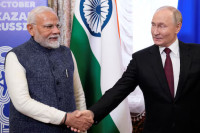Opinion
To Teej or not to Teej
Don’t define or redefine or celebrate Teej if you don’t want to—as long as you don’t make fun of the women who celebrate it
Aditi Adhikari
Each year as Teej rolls around, I find myself looking for excuses to celebrate it. As someone who doesn’t believe in penance, it has always been relatively simple for me to celebrate Teej in whatever way I feel like. But I also identify strongly as a feminist, and in that capacity, I have struggled with the festival. For many years, I worried that by celebrating Teej, I was being complicit in society’s placing so much value (too much, in fact) on a good husband (of a good caste and social standing, and someone who is hopefully better-qualified and better-earning than you).
So how have I come to terms with the festival?
Blue vs pink
Gender segregation is fed into our minds from the day we are born, starting with how our parents dress us up and what toys they buy for us—pink versus blue, dolls versus cars. Fairy tales, movies, and literature teach young girls that a good man is all they need to live happily ever after. Many of our traditions are also gendered; the Bratabandha is a ceremony done for young boys and not girls, and I have always found the Kanyaadaan ceremnony, where the bride’s parents give her away to the groom, shocking.
On the other hand, I find the Teej vibe quite liberating. In most festivals, I see the women busy in the kitchen while men talk, feast and gamble. Prior to the day of Teej (‘dar khaaney’), women cook and women eat, they get decked up and visit their friends and family, and they dance, regardless of who’s watching.
For a long time, I understood Teej to be a festival where unmarried girls fasted for a good husband, and where married women prayed for their husband’s long lives. But a few years ago, my grandmother, well into her 70s, told me that Parvati didn’t fast for a good husband; she fasted to protest her father’s decision to get her married to Bishnu, whom he deemed appropriate for her, and to actually marry Shiva, whom she wanted to marry. She fasted as a sign of devotion. She fasted to take her life into her own hands by choosing her own partner. That is at least my grandmother’s interpretation of the festival. I know from her that women have always defined and interpreted Teej in their own ways.
Last year, I participated in a panel of millennial women to talk about our respective experiences of Teej. I talked about how I have, over the years, developed my own understanding of the festival. Some of the attendees did not buy into that argument. For them, Teej has a deeply patriarchal feeling, with women getting gifts from their brothers to make up for the inheritance that they’re not given, and fasting for their husbands. To them, red bangles and ‘poteys’ only weigh women down.
But throughout the world, women continue to breathe new meaning into their choices; short skirts and high heels, known to many older feminists as things that restricted women’s movement, have become popular once again. Of course, our choices are often shaped by ideas of what is virtuous, which is influenced by the patriarchal society around us. But our choices also influence society, regardless of our position in it. Last year, I found the perfect red lipstick. I was in the middle of a very busy year, and I questioned myself about why I felt the need to wear makeup, when my male friends and colleagues embraced their bare faces. What made me question the purchase even more was the thought of my nieces and cousins; the thought that they would see me, and think that a woman needs to wear makeup to look good. I deliberated for a long time about how I would explain this lipstick to the little girls in my life, and then I bought it.
Traditions change
One day I will have a little girl, and I will have to explain Teej to her. I will start with the history. And then I will go on to tell her what my grandmother told me, and explain to her what the festival means to me, and tell her that it can mean something else to her.
A friend of mine recently vented on a Facebook post, “Why should [women] not pray for the long life of their husband in a society where widow marriage was forbidden? It scares me to even think of the plight of these women in a society where widows are treated like outcast, where it was not that long ago that sati pratha used to be the norm of the day.” It would be wrong to claim that all women have the freedom to interpret Teej as they wish. In fact, one of the other panelists at the discussion mentioned above talked about the pressures to embrace Teej and keep a fast that the women in her family face every year. But these days, we don’t hear of women passing out because of dehydration, which was common news during my childhood. As societies change, as people and their perceptive change, traditions and the meanings they carry also change. Teej is also evolving.
You don’t have to define or redefine or celebrate Teej, if you don’t want to. You can choose to chuck it out of your personal basket of traditions altogether, as long as you don’t make fun of the women who do celebrate it. Maybe you can also hear their interpretations of the festival, with an open heart.
I was 11 when I first tried to fast during Teej. It was a few months after my Gunyo Cholo, and in my dark red Banarasi sari, I felt very grown up, almost as graceful as my mother. I’m not sure whether I kept my fast the whole day, but I did wear my sari the whole day. Since then, I have fasted most years, in different ways; one year, when I was in college, I forgot to bring a stash of fruits from the dining hall, and broke my fast at midnight with a lamb sandwich. This year, I have to go to work, so I’m not fasting, but I do wish I had the day off to chill with my mom and aunts instead. And I do want a good husband, but I don’t know if fasting is going to get me that. Asking a person with similar characteristics as that of Shiva out on a date might be a better gameplan!
Adhikari is an educator and a feminist




 11.12°C Kathmandu
11.12°C Kathmandu








%20(1).jpg&w=300&height=200)

